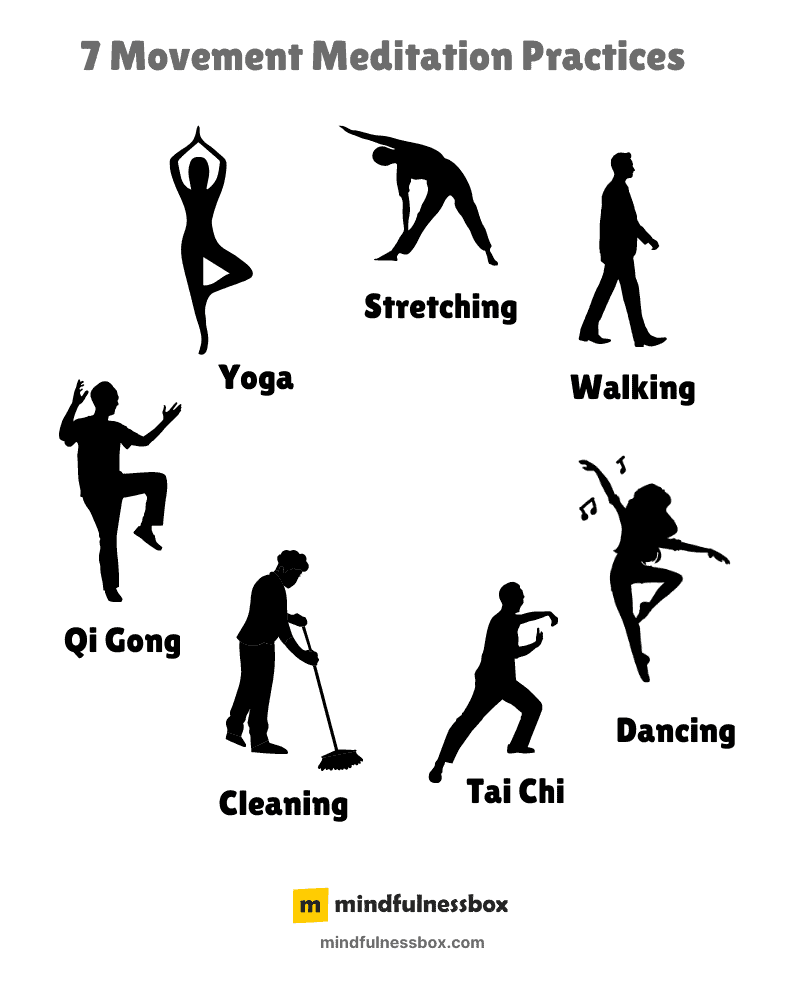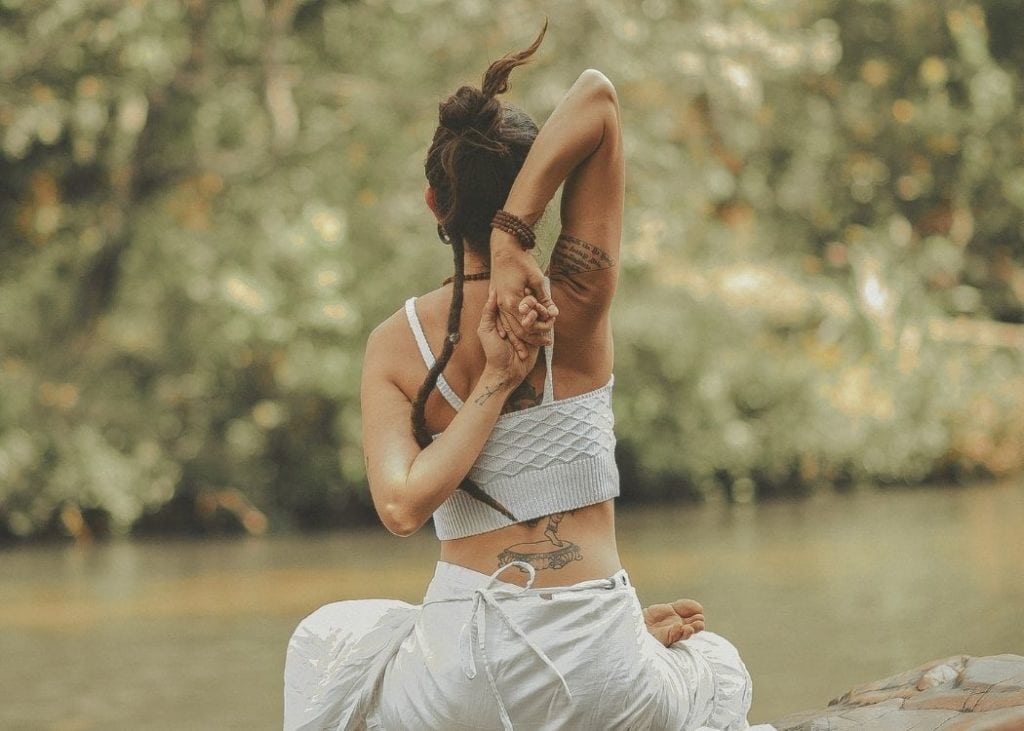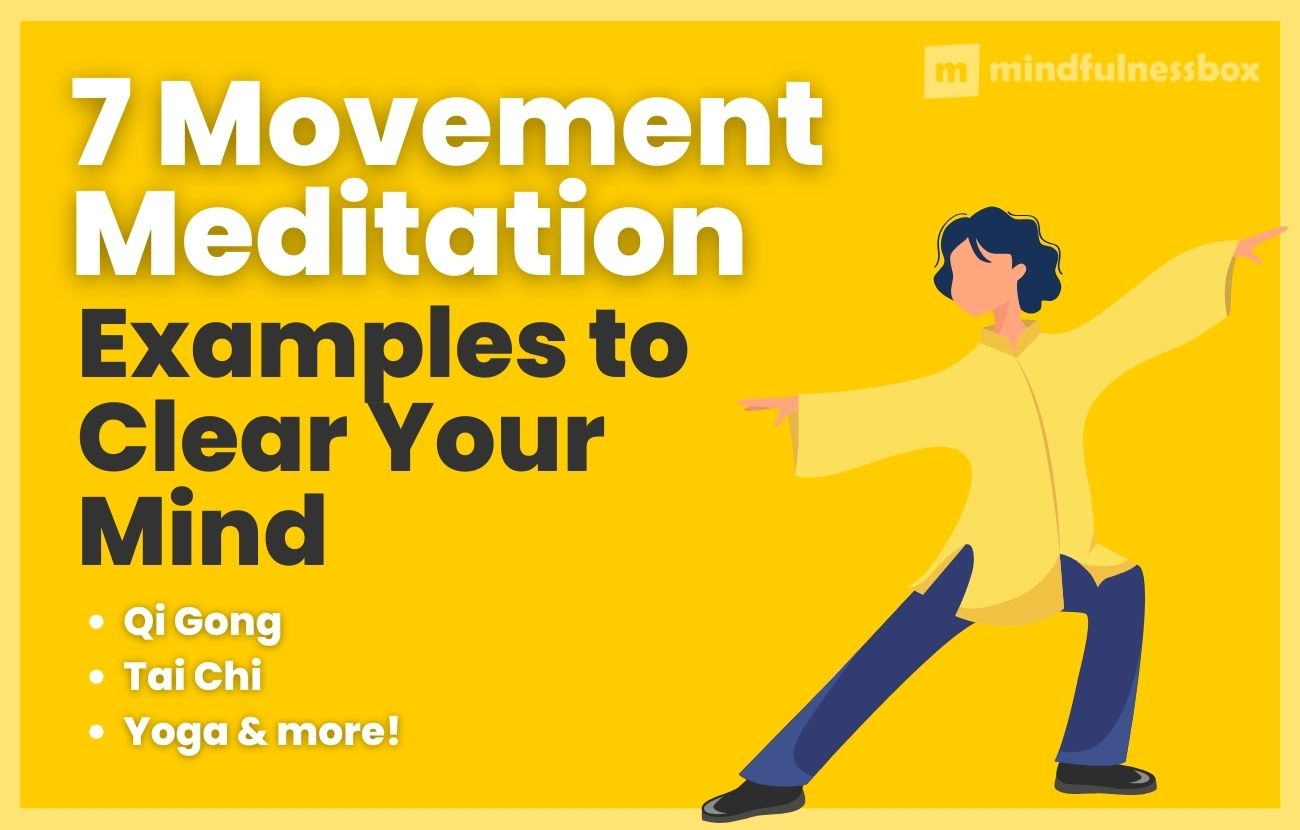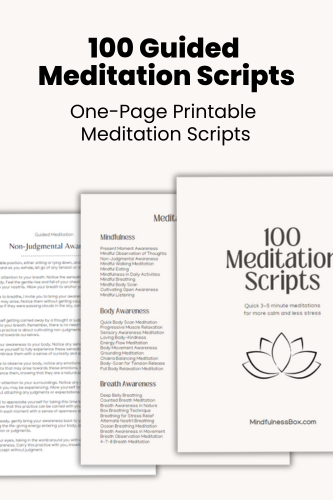Movement meditation techniques like yoga, walking meditation, and tai chi are a way to bring a more active energy to your meditation practice. We often think of meditation as a practice that happens in stillness – but it doesn’t have to be, as long as you’re still paying attention to the present moment, nonjudgmentally.
Some years ago during the course of a 10-day silent meditation retreat, I was introduced to the concept of walking meditation.
These 100 meditation scripts were created to help beginner and intermediate meditators practice key mindfulness concepts like self-love, forgiveness, gratitude, and inner peace.
Designed to fit into busy schedules, each meditation script lasts 3-5 minutes. Perfect for starting or closing a group meditation; for yoga, coaching, or therapy sessions; or for your personal meditation practice.
At the retreat center, there was a short U-shaped walking trail that led into the woods and circled back to the center.
After spending hours and hours per day in seated meditation, I was eager to try walking meditation, especially if it meant I could give my tired body a break from being seated.
What I noticed was that there’s an entirely different energy I experienced walking in the world with mindful intention versus walking in the world on autopilot. As I moved slowly along the walking trail, noticing leaves crunching and birds chirping and warm sunlight on my arms, I realized that this is also what “regular” life could be, if we could only remember to notice.
To me, that’s one of the beautiful things about “meditation in motion.” You’re teaching your body not just to be mindful while sitting on your meditation pillow, but to be mindful out in the world.
What is movement meditation?
If regular meditation is, as Jon Kabat-Zinn says, a way to pay attention to the present moment nonjudgmentally, then movement meditation is the same thing: you just move and meditate at the same time.
Think of it as “mindfulness meditation movement.”
Of course, there’s a different dynamic between moving and sitting, and the challenges of maintaining your attention are different.
Walking meditation and yoga are a couple of well-known movement meditation techniques. Others, like qigong, are less known. Still others, like dancing and mindful cleaning, aren’t normally thought of as avenues for meditation.
Let’s dive into seven of the most common meditative movement techniques.
7 movement meditation examples
Sometimes, sitting meditation just isn’t enough. These seven forms of meditation in movement are worth exploring if you’re looking to add a more dynamic energy to your meditation practice.

1. Walking meditation
Walking meditation is simple, and a great place to get started with movement meditation.
Walk, perhaps more slowly than you normally would, and as you walk, pay attention to everything you wouldn’t normally pay attention to. Taking your shoes off and going barefoot can help, as can focusing on your breathing.
How does it feel when your feet hit the ground? What do you notice, that you don’t normally notice? What’s the difference between walking with your eyes closed and eyes open?
Simple walking meditation techniques:
- Find a quiet, flat path where you can walk back and forth undisturbed.
- Stand still for a moment with your feet shoulder-width apart, knees slightly bent, spine upright, and relax your body. Take a few deep breaths.
- Slowly begin walking at a natural pace. Focus on the sensations in your feet and legs as you walk: the motion, the contact with the ground, your breathing.
- Walk for 5-10 minutes if you can. If thoughts arise, gently acknowledge them and return your focus to the walking.
- When you’re ready to finish, stand still for a moment again and take some deep breaths before continuing on with your day.
2. Yoga

Perhaps the most well-known form of movement meditation, yoga is an entire practice unto itself. In fact, in a traditional context, meditation is considered to fall under the umbrella of yoga. Yoga is a bigger-picture, all-encompassing philosophy and approach to life.
But the most commonly understood practice in yoga are the asanas, or poses, and that’s exactly what you want to focus on during your moving meditation. Yoga provides an interesting challenge for your mind and body: to continue focusing on your breath, even as you move your body in sometimes strenuous ways.
Of course, seated meditation pairs well with yoga, too. Seated meditation is usually done after yoga, once the body is already loosened up.
Basic yoga instructions:
- Find a quiet, comfortable space to practice. Use a yoga mat if you have one. Wear comfortable clothes that allow you to move freely.
- Start in mountain pose, standing tall with feet together or hip-width apart. Relax your shoulders. Breathe deeply.
- Do 5-10 rounds of sun salutations. Move slowly through poses like upward salute, forward fold, low lunge, downward dog, cobra, downward dog again before returning to standing. Focus on your breath.
- Move through some standing poses like warrior I and II, triangle pose, tree pose. Hold each for 5-10 breaths.
- Do some stretches on the floor like seated forward fold, butterfly pose, twist pose. Hold for 5-10 breaths.
- Finish in savasana, lying flat on your back with arms at your sides, palms up. Close your eyes and breathe deeply for 5-10 minutes.
3. Tai chi
Tai chi is a physical exercise that involves specific postures combined with “clear mind movement.” Originating in China, it’s known as a way to reduce stress in the body, and is particularly popular as a low-impact activity.
Unlike yoga, which is about holding poses, tai chi is defined by consistent, slow motion from one pose to the next. When you watch it, it’s almost as if you’re watching martial arts in slow motion.
Tai chi instructions:
- Stand with your feet shoulder-width apart, knees slightly bent, spine upright, and relax your body.
- Take a few minutes to breathe deeply and center yourself. Focus on slow, calm breathing.
- Slowly move through the starting Tai Chi pose. Hold your arms out with palms down. Breathe in as you shift your weight to one foot and lift the other heel.
- Moving deliberately, shift your weight between feet, alternately lifting and setting down heels. Keep knees bent, back straight.
- Transition smoothly between movements. Flow from pose to pose at an unhurried, steady pace.
- Align your body so weight is centered between feet, knees above ankles, back upright. Breathe fully and deeply with each movement.
- Move your arms and hands slowly as if through water. Keep motions gentle and graceful.
4. Qigong
Qigong is a practice that combines postures, breathing, and meditation with movement. Originating in China, qigong can include static meditations and postures like yoga, but more often focuses on carefully choreographed dynamic movements.
Important to qigong is the principle of maintaining a balanced, flowing style as you transition from one moving meditation to the next, as well as deep, rhythmic breathing and maintaining a calm awareness.
Qigong is also unique for its interpretation of the movements of animals. Many qigong poses are based around the movements of real and mythical animals like tigers, geese, cranes, and dragons.
Qigong instructions:
- Stand with your feet shoulder-width apart, knees slightly bent, spine upright. Relax your body.
- Take a few minutes to center yourself. Close your eyes and breathe deeply into your abdomen.
- Bring your hands to your lower abdomen, one hand over the other. Breathe deeply into your abdomen and feel it expand with the inhalation.
- Gently and slowly, move your hands outward and upward as you exhale. Stretch your arms and body.
- Continue breathing deeply. As you inhale, sweep your arms down and inward gathering energy. As you exhale, push the energy out and away from your core.
- Repeat this movement sequence 5-10 times, coordinating with the breath. Move smoothly and meditatively.
- Transition into other slow, graceful Qigong arm and body movements. Maintain deep, calm breathing.
- Flow through the movements for 10-15 minutes. End back at starting position and take a moment for stillness.
5. Mindful Dancing

Have you ever lost yourself in dancing? Getting totally out of your mind and into the experience of truly inhabiting your body is one of the attractive elements of dancing.
Ecstatic dance is one practice that seeks to create the conditions for this to happen by creating a supportive and creative environment for movement in which “anything goes.”
At first glance, dancing doesn’t seem to have much in common with meditation. But if you’re able to dance while encouraging yourself to stay in the present moment, focusing on your breathing, and bringing yourself back to your body when you get distracted by thoughts – that’s it! You’ve discovered meditation through movement.
Mindful dancing instructions:
- Put on music that makes you want to move: whatever inspires you!
- Allow your body to start moving however it wants. Don’t judge your dancing. There’s no right or wrong. Just feel the music.
- Stay present in each moment. Notice the sensations in your body as you move – your feet on the floor, the rhythmic motions, your breath.
- Let go of thoughts and self-criticism. When your mind wanders, gently bring it back to sensing your body in motion.
- Express yourself freely through dance. Move in ways that feel good. Dance for at least 5-10 minutes.
- When the music ends, pause in stillness again with eyes closed. Observe how your body feels after moving mindfully.
- Appreciate dancing as a form of meditation in motion. It connects you with your inner joy.
6. Mindful stretching
Stretching can be a moving meditation in the same way that yoga, tai chi, and qi gong are. It’s much more unstructured, so you simply need to bring some intentionality to the activity.
As you perform your stretches, take a moment to deeply reflect on how your body is feeling. Notice how the sensations in your body change as you stretch in different directions, and as you stretch different parts of your body. Do your best to continue focusing on your breathing while stretching.
Mindful stretching instructions:
- Bring your awareness to your body. Notice any tension or tightness.
- As you breathe, gently stretch the area, moving slowly and holding the stretch for 15-30 seconds. Focus on how it feels, without judgment.
- For example, interlace your fingers and stretch your arms out in front of you on an inhale. Feel the tension in your shoulders, back or arms.
- With each exhale, relax deeper into the stretch. Breathe into any areas of tightness. Release back to center.
- Continue stretching different muscle groups (legs, hips, back, neck) with mindful awareness. Listen to your body.
- Between each stretch, return to neutral and take a few mindful breaths before moving to the next area.
- Close by gently shaking out your body and taking a few grounding breaths with your eyes closed.
7. Mindful cleaning

Mindful cleaning is an old Zen Buddhist practice. In my mind, it’s one of the great hacks of life because it allows you to multitask while cleaning, and makes the experience of cleaning much more pleasant.
Engaging in mindful cleaning is simple. Rather than rushing through a cleaning task, with mental tension driven by the fact that you wish you didn’t have to be doing it, you instead pay close, careful, loving, curious attention to what you’re doing. Washing the windows becomes not a task you rush through, but a task you let linger. You focus on each action you take, and on how progressively cleaner the windows are getting, and you let your mind be at ease.
When I remember to clean mindfully, a kind of switch fires in my brain. The activity I had just been forcing myself through becomes smoother and easier. There’s a change that happens when I start to pay attention to the details of actually doing it, rather than wishing I wasn’t doing it, or that it would end soon.
In an article by David Cain at Raptitude, he quotes a friend of his who loves washing dishes for its mindfulness benefit:
“Life is composed of primarily mundane moments,” she says. “If we don’t learn to love these moments, we live a life of frustration and avoidance, always seeking ways to escape the mundane. Washing the dishes with patience and attention is a perfect opportunity to develop a love affair with simply existing.”
from David Cain at Raptitude
Mindful cleaning instructions:
- Work slowly and deliberately. Pay attention to the sensory experience: sights, textures, sounds, smells.
- For example, when washing dishes feel the warmth of the water and the smoothness of dish surfaces. Listen to the sounds of splashing. Enjoy any aromas from soaps.
- If your mind wanders, gently return your focus to the sensations of cleaning.
- Notice if any emotions come up and acknowledge them without judgment before refocusing.
- Bring curiosity and appreciation to the tasks. Consider the origins of the items you are cleaning.
- Pause periodically to take conscious breaths. Feel your connection to the environment you are cleaning.
- When finished, pause to notice any sense of satisfaction from your efforts before transitioning to your next activity.
How to get started with moving meditation
When starting new mindful movement practices, like any new practice, it’s easy to get caught up in whether you’re doing it “right.”
That’s especially true for practices like yoga and qigong, which can feel technical and complicated at the beginning. If you find yourself drawn to those practices, try to avoid aiming for perfection. Don’t worry about whether you’re doing it right. Just pull up a YouTube video, do your best, release your expectations, and see how it feels.
If you’re just starting out, perhaps give walking meditation a try first. It’s one of the best practices for beginners, and has almost zero learning curve.
And if you’re looking to add a new angle to your movement meditation exercises, dancing meditation or mindful cleaning could be for you.
The more you can release meditation from the confines of your seated practice and into the real world, the more you’ll notice the benefits of bringing awareness into your everyday life.

My mindfulness practice kicked off in 2016 with a ten-day silent retreat. Since then, I’ve read dozens of books about mindfulness and completed hundreds of hours of meditation. Thinking about what makes humans happy, calm, and peaceful is endlessly fascinating to me.


